Diving with Sharks on Aliwal Shoal
May 05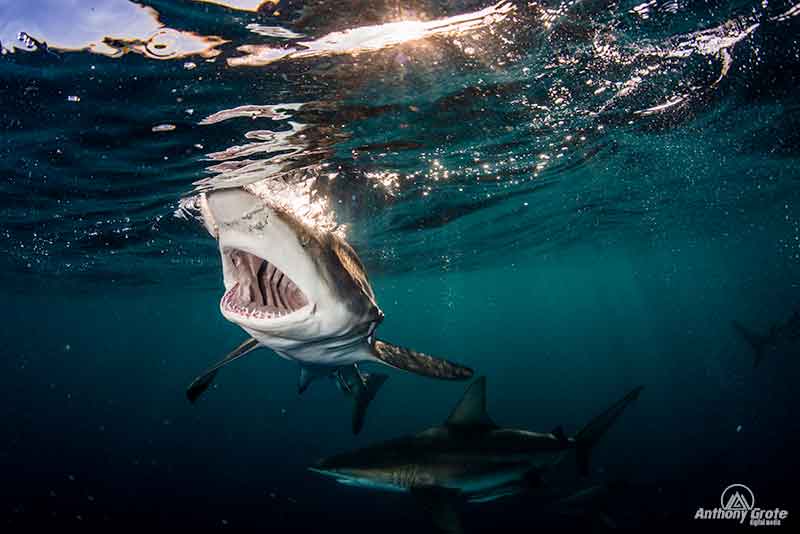
If anyone has heard about Aliwal Shoal, it will shortly be followed by some comments about sharks. South Africa’s East Coast is well known for its shark populations, with Aliwal Shoal and Protea Banks being the most well-known and dived areas. When it comes to general diving, Aliwal Shoal is probably the most dived and offers the more accessible option, and with the better chance of seeing sharks on a dive. We have been diving this reef system for more than 20 years and have developed some great dive plans and exciting days out on the water to maximize what we photograph, and the conditions in which to photograph these incredible creatures of the oceans.
Aliwal Shoal is a world-renowned dive site located off the coast of KwaZulu-Natal in South Africa. The shoal is named after the near sinking of the vessel, the Aliwal, in 1849, and is a narrow rocky reef that stretches for about 5 km along the coast. The reef is situated about 5km directly offshore from Scottburgh, and the South Coast of KwaZulu-Natal in South Africa, and is home to an abundance of marine life, including a diverse range of fish species, sharks, rays, and turtles. One of the main attractions of diving at Aliwal Shoal is the opportunity to see the Ragged Tooth Sharks, which migrate to the area during the winter months. These magnificent creatures, also known as Sand Tiger Sharks, are the most commonly encountered shark species at Aliwal Shoal, and they are well-known for their distinctive appearance and docile behavior.
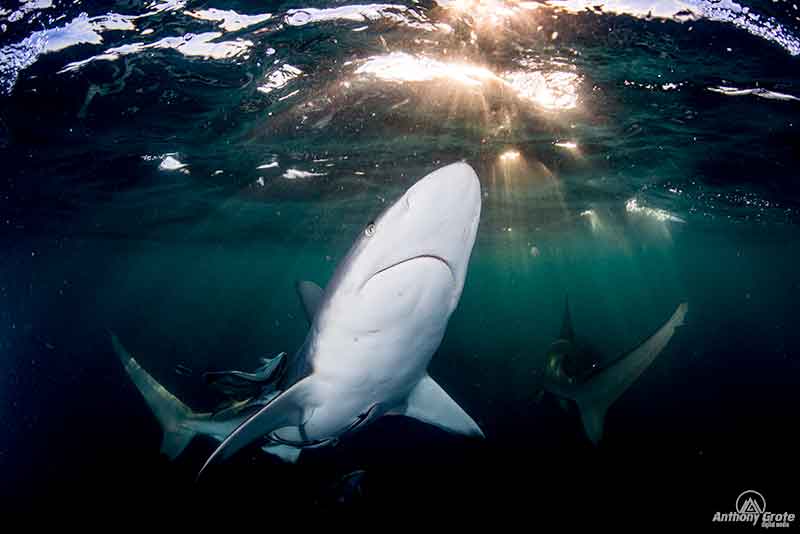
Sharks swimming near the surface at Aliwal Shoal
There are a number of locations in which to find these sharks as they escape the currents during the day. The most sought-after dive locations are Raggies Caves and Cathedral. Most days one will find anywhere from 3-15 or more sharks taking refuge in these caves and overhangs.
The other diving experience for which Aliwal Shoal has become well known is the oceanic black-tip shark dive. Here a bait drum is immersed into the bleaters just off the Shoal itself, where it then drifts in the current, sending an oil slick downstream, hopefully catching the attention of the resident sharks in the area. Often this “baiting” is not even required, as these sharks have been used to the boats and arrive not long after the boats have settled into the area. One can often get a variety of shark species on these dives, with the Blacktips being the more common (anywhere between 2 to 20 sharks at a time), but with Tiger Sharks often appearing, and even a Great White if one is lucky enough.
To maximize our time on the ocean, and to create images both in reef and in the blue water, we plan a whole day on the water, starting with an early morning boat launch through the waves, either from Umkomaas or Rocky Bay. First stop is the Shoal itself, with some deep dives to either Raggy Caves or Cathedral, those fully capture those iconic “grinning teeth” images for the Ragged Tooth Sharks as they drift around the caves and overhangs. These dives are often a hit or miss, as the one variable one cannot account for is the visibility on the Shoal, which can be 5m one day, and 35 the next, depending on the currents.
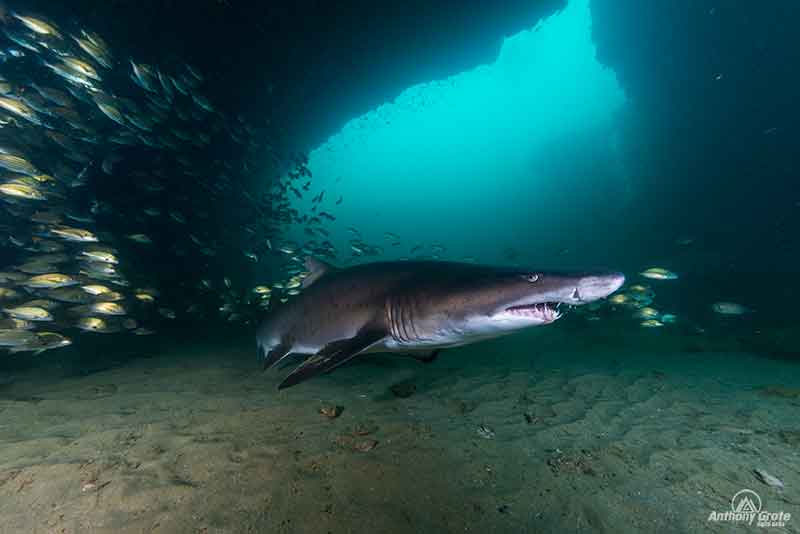
A shark at Aliwal Shoal
After 2 exploratory shark dives on the Shoal, we move off the reef and into the blue water and start our real shark photography. Drifting with sharks in the blue is an incredible experience, playing with light reflecting off the surface of the ocean, as well as experiencing their behavior, is something to savor, and something one will never forget. Working through the afternoon with the changing light conditions is the most rewarding part of the day, shooting into sun, as well as away, offers two different scenarios in which to get totally different results. Then the prime lighting arrives around sunset, with the oranges and soft lighting both above and below the water line. Overunders become our target shots, and we work this “sunset hour” to the max, as many shots are hit or miss, but just hoping for that one image that stands out from the rest.
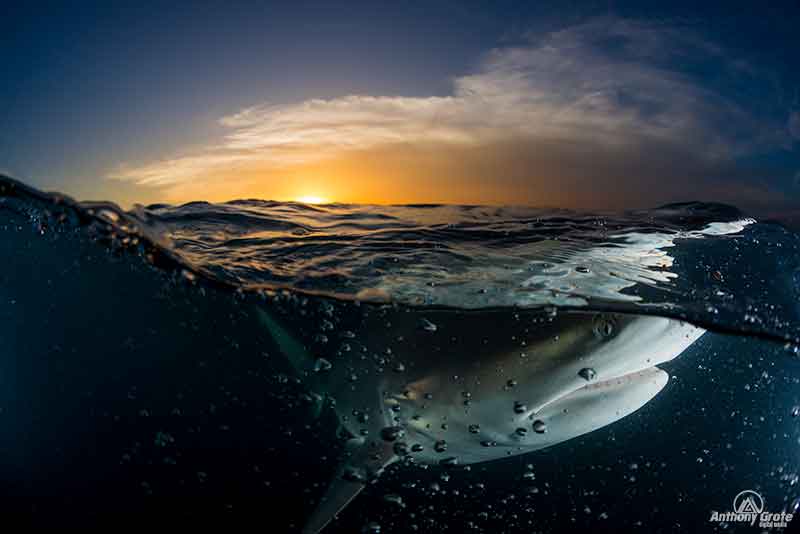
A shark just under the surface at sunset.
After the sun has set, gear is packed away and we head for home, navigating using the lights on the shore, and experienced skippers that know the local water the best.
Recommended gear from these type of trips generally include cameras with a high shutter rate, including you top end DSLR’s such as the Nikon D850 or Canon EOS 5D Mark IV, other as technology moves more to the mirrorless cameras, the Sony A7R V, Nikon Z7ii, or the Canon EOS R5. As for lenses, obviously this is wide angle territory, fisheye lenses being your best option, otherwise a wide rectilinear lens such as the 16-35mm F4. For the over under images, we would recommend the fisheye as a minimum, together with a large dome port, such as the Nauticam 230mm optical glass dome port II, Marelux 230mm optical glass port or the Sea & Sea Fisheye dome port 240. The other essential items are strobes. As sharks are fairly fast-moving animals, you will require strobes with a fairly high power output (high Guide Number), and a high recycle rate. The recommended strobes would be something along the lines of the Sea & Sea YS-D3ii, as your best option.
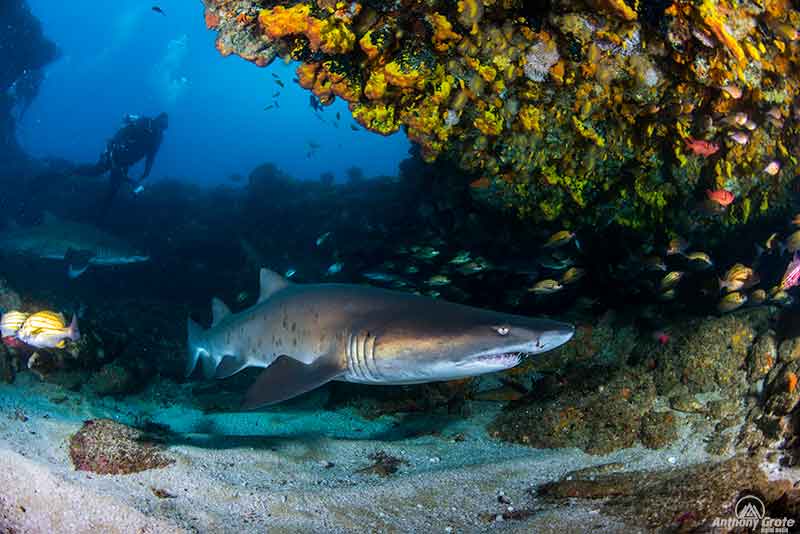
Sharks at Aliwal Shoal
If you wish to join us on one of these ocean adventures, don’t hesitate to make contact, and we can ensure a memorable day on the ocean.





Related Articles
Popular Articles